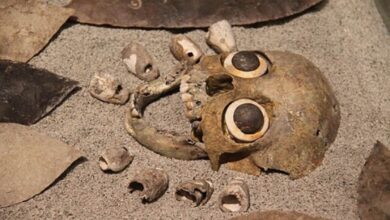The Mexican Man Who Survived a Galapagos Shark Bite And Went Back to Thank It

When marine biologist Mauricio Hoyos felt the crushing bite of a Galapagos shark clamp around his head, he thought his life was over. Instead, the attack deepened his respect for the misunderstood predators he’s spent decades studying and protecting, BBC Mundo reports.
A Moment Between Life and Teeth
It began with sound — the muffled crunch of serrated teeth meeting bone under forty meters of Pacific water. Mauricio Hoyos didn’t even see the shark coming. One second, he was gliding through the blue off Costa Rica’s Cocos Island, tagging Galapagos sharks for a migration study. Next, a three-meter female was upon him.
“When it closed its jaw, I felt the pressure of the bite,” he told BBC Mundo from his home in Baja California. “Then, after what I think was a second, it opened it again and let me go.”
His tone was calm, almost analytical, but the scene he described was pure nightmare. The shark’s jaws crushed his mask, tore apart his oxygen hose, and left deep gashes across his face and skull. The water around him filled with blood. He could barely see.
A lesser diver might have panicked and drowned. Hoyos, who has spent more than thirty years studying sharks, relied on training and instinct. He switched to a backup regulator, only to find it blasting air uncontrollably. “It was blowing instead of regulating,” he said. “I had to remember my training and start regulating it with my lips.”
He swam upward through a haze of red, guided only by the shimmer of sunlight above. When he finally broke the surface, gasping, the crew pulled him aboard. Blood streaked down his wetsuit, but he was alive.
To doctors, his survival bordered on impossible. To Hoyos, it was something else: a message. “This bite was like a dog’s — a warning, not a kill,” he said.
The Day the Ocean Bit Back
That September morning had started like hundreds before. Hoyos and his team were tagging sharks to understand their courtship and migration routes — vital data for protecting endangered populations. Tourists on a nearby boat spotted an extensive female cruising below. Hoyos dove after her, tagging the probe in hand.
He managed to prick her dorsal fin, but instead of fleeing, the shark turned. Slowly. Deliberately. “I saw her little eye looking at me,” he said. “She very calmly turned around.”
The calm exploded into violence. She lunged, jaws wide. Hoyos ducked his head, and the lower jaw clamped his cheek while the upper crushed the top of his skull. The impact felt, he said, “like being hit by a car.”
Even after releasing him, the shark circled once before fading into the blue. Below him drifted the silence of the abyss; above him, the promise of air. Every kick upward became a calculation — blood loss versus buoyancy, oxygen versus panic.
When his head finally broke through the surface, his crew raced to haul him aboard. The captain radioed park rangers for help. Paramedics met him at the shore, stunned to find he was conscious. Despite the blood and torn skin, the bite had missed every major artery. Infection never set in.
The doctors called it “miraculous.” Hoyos called it “forgiveness.”

A Scar and a Story
The wound healed, but it never disappeared. Across Hoyos’s face runs a long, curving scar — “a battle scar that looks like gills,” he says. It’s a mark he wears with quiet pride. “This is proof the shark spared my life. I can’t put it any other way.”
Surgeons in Mexico performed delicate reconstruction, worried about infection near the brain. Within days, his recovery stunned them. “They were surprised by how quickly I healed,” he said. Compared to another Galapagos shark survivor in 2017, who spent a month in a hyperbaric chamber, Hoyos was walking within a week.
He credits his composure underwater, honed by decades among predators that most people fear to name. “I’ve always said sharks are not monsters,” he told BBC Mundo. “They’re just misunderstood.”
His empathy runs deep. Even while bandaged, he refused to let anyone call the shark “aggressive.” To him, the attack was a miscommunication — a territorial warning, not vengeance. “Humans provoke far more harm to sharks than they ever do to us,” he said.
He points to the global decline of shark populations — up to 70% lost in the last half-century due to finning, illegal fishing, and pollution. “If we lose sharks,” he said, “the ocean collapses. It’s that simple.”
Back Into the Deep
By November, barely two months after the attack, Hoyos was back underwater. Friends and colleagues urged him to rest, but he couldn’t stay away. “I already have a dive planned,” he said with a grin. In January, he would return to Cocos Island — to the very spot that nearly killed him.
He has no desire for revenge—quite the opposite. Thanks to the tag he managed to place before the bite, he might see the same shark again. “If I do,” he said, “I’ll recognize her. Not as an enemy, but as a teacher.”
That idea — learning from what hurt you — has become his creed. Hoyos now works with schools and conservation groups, turning his scar into a living lesson. He shows children photos of his face before and after, then of the shark itself: powerful, sleek, misunderstood. “This scar allows me to keep speaking well of sharks,” he says. “It gives me a story to tell, and a reason to keep protecting them.”
When asked whether he feels fear in the water now, he laughs softly. “Of course I do,” he told BBC Mundo. “But fear is part of respect.”
He knows what the ocean is capable of — beauty and brutality, sometimes in the same breath. Yet, in his eyes, that balance is sacred. “The ocean forgave me that day,” he said. “And I owe it my life.”
Today, somewhere beneath the shimmering surface of Cocos Island, a tagged Galapagos shark still glides through the currents — a silent reminder of how thin the line is between predator and prey, and how one act of mercy beneath the waves turned a man into the sea’s most devoted defender.
Also Read: Leading With Care: Latin American Women Are Rewriting Burnout And Business Culture





